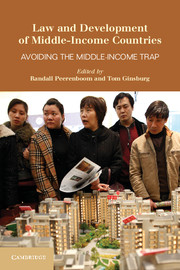Book contents
- Frontmatter
- Contents
- List of Contributors
- Acknowledgments
- 1 Law and Development in Middle-Income Countries
- Part I The Politics of Development in Middle-Income Countries
- Part II Middle-Income Countries in a Globalized Economy
- Part III Good Governance and the Rule of Law in Middle-Income Countries
- Part IV Socioeconomic Challenges in Middle-Income Countries
- 11 The Role of Courts and Constitutions in the New Politics of Welfare in Latin America
- 12 The Judicialization of Health Care
- 13 Nascent Protections in Emerging Giants
- 14 Environmental Challenges in Middle-Income Countries
- Part V International Donor Strategies for Middle-Income Countries
- Appendix Selected Country Data as of 2011
- Index
- References
12 - The Judicialization of Health Care
Symptoms, Diagnosis, and Prescriptions
Published online by Cambridge University Press: 05 June 2014
- Frontmatter
- Contents
- List of Contributors
- Acknowledgments
- 1 Law and Development in Middle-Income Countries
- Part I The Politics of Development in Middle-Income Countries
- Part II Middle-Income Countries in a Globalized Economy
- Part III Good Governance and the Rule of Law in Middle-Income Countries
- Part IV Socioeconomic Challenges in Middle-Income Countries
- 11 The Role of Courts and Constitutions in the New Politics of Welfare in Latin America
- 12 The Judicialization of Health Care
- 13 Nascent Protections in Emerging Giants
- 14 Environmental Challenges in Middle-Income Countries
- Part V International Donor Strategies for Middle-Income Countries
- Appendix Selected Country Data as of 2011
- Index
- References
Summary
INTRODUCTION
Middle-income countries (MICs) are, by definition, in a gray zone. As with middle classes within domestic societies, they find themselves in an intermediate ground between precariousness and opulence. Their essence is one of contrasts, as shown by the disparate geography of their large cities, from São Paulo and Delhi to Jakarta and Johannesburg.
Economic contrasts go hand in hand with institutional contrasts. The institutions of MICs are hybrids: in them coexist elements of weakness and strength, incapacity and capacity. On some occasions, there is disparity between different institutions – for example, between an authoritarian government captured by private interests, on the one hand, and an independent judiciary that protects citizens’ rights, on the other. In others, the asymmetry is found within a single institution – for example, a tax-collecting agency or police force that is efficient in the cities, but absent or incapable of fulfilling its mission in the rest of the country.
This double economic and institutional contrast makes MICs particularly fertile ground for the judicialization of conflicts regarding socioeconomic rights (SERs). Among the economic variables that favor judicialization, income level and distribution stand out. By definition,MICs have more resources than low-income countries (LICs), but tend to have a distribution of wealth just as or more unequal than the latter.
The aforementioned institutional asymmetry increases the probability that these demands turn into litigation. This is because governmental agencies are not sufficiently strong to adequately and regularly resolve citizen petitions, but (in contrast to what happens in LICs) do tend to be sufficiently strong and accountable to fulfill judicial orders. When courts are independent and have adequate institutional capacity, litigation offers a particularly promising route to demand the fulfillment of SERs.
- Type
- Chapter
- Information
- Law and Development of Middle-Income CountriesAvoiding the Middle-Income Trap, pp. 246 - 269Publisher: Cambridge University PressPrint publication year: 2014
References
- 8
- Cited by

